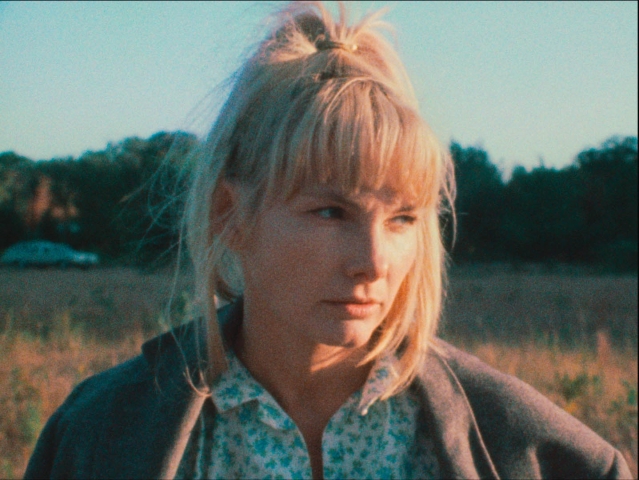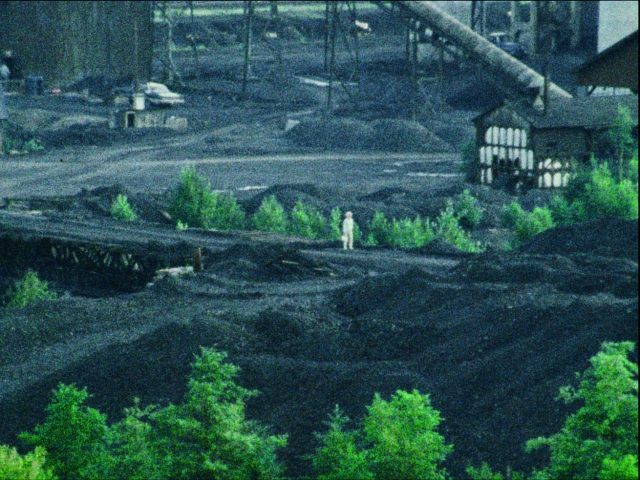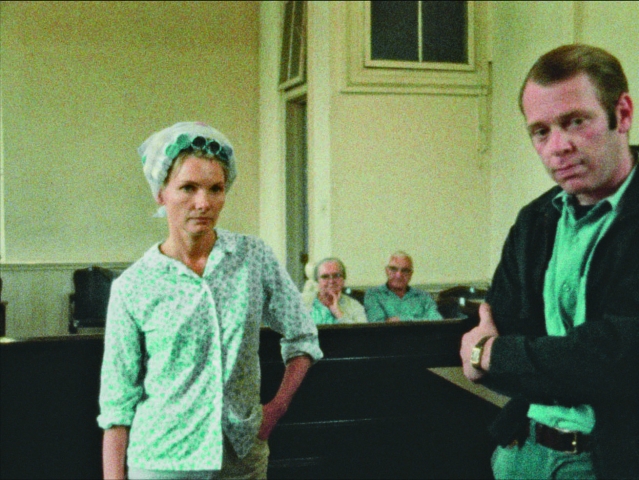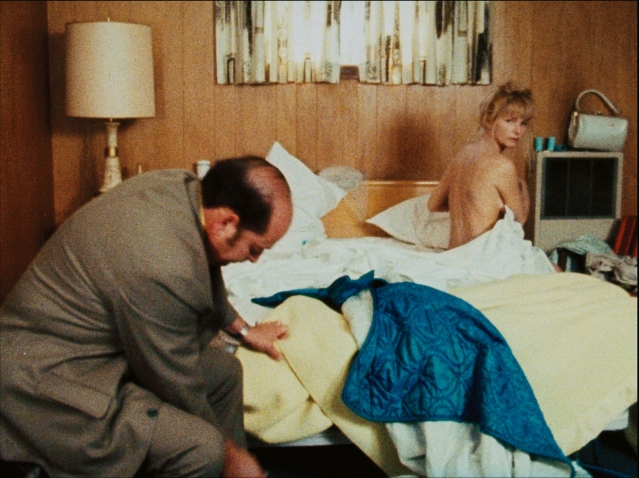Issue 218, Fall 2016

Seen from a distance, a woman, etched against the darkness. Whether it is a woman, in fact, is hard to tell, we’re so far away. Framed by mountains of rubble, a tiny white figure, barely more than a dot against the dark expanse, slowly and steadily picks its way through this huge mass of debris: a vast, towering slag heap, intersected with great mounds of excavated rock, stony depressions, muddy tracks waiting to be ploughed up by the trucks. In a wide-angle shot, we follow this minute, ethereal figure as it makes its way intently along the forbidding horizon. At times the dust absorbs and dissolves the figure as it doggedly moves on, lit up for a moment, now just a vague smudge, now almost transparent, like a backlit hole in the picture, a blind spot on the decimated landscape. Yes, it is a woman.
Later we see her sitting at the back of an empty bus, gazing out but seeing nothing, and we hear her name, twice, as though it were being flung, Wanda, Wanda, a man’s voice, casting over the story a muted, anxious question, the only time he utters her name.

We are inside the house now; we see the meagerly furnished rooms, things left lying about, an old woman sitting in the back holding a rosary, her face yellow in the pale, streaky light, gaze fixed hard on something that disappeared long ago. We pan back a little; a child is running around her. We pan back farther and see a woman from behind, she’s wearing a nightdress, her disheveled hair is pinned up, her weary shoulders droop . . . we think this must be her, this must be the heroine. We pan back farther still; there is a baby on a bed, crying. We glide toward the dimly lit kitchen, she has taken the infant in her arms, we wonder where she will find milk, she moves slowly, sighs, opens the refrigerator, moves some dishes out of the way, vaguely tries to calm the cries. A man suddenly appears, the father presumably; he passes through, muttering, exits. We follow him; the door slams as we see a body stretched out under a sheet, a blonde woman, about thirty, slowly emerging. There are hair curlers and drink cans on the floor by the couch. She sits up, still half asleep, He’s mad because I’m here, she looks out of the window, the forbidding horizon is choked up to the sky, trucks are maneuvering in the dust. It’s her, it’s Wanda.
The American actress and director Barbara Loden told this woman’s story in the 1970 film Wanda, the only film she ever directed and in which she also played the leading role. Barbara Loden is Wanda, as they say in the movies. Her inspiration for the screenplay was a newspaper story she had read about a woman convicted of robbing a bank; her accomplice was dead and she appeared in court alone. Sentenced to twenty years in prison, she thanked the judge. Interviewed when the film came out, after it had been awarded the International Critics’ Prize at the 1970 Venice International Film Festival, Barbara would say how deeply affected she had been by the story of this woman—what pain, what hopelessness could make a person desire to be put away? How could imprisonment be relief?
A woman appears from within the folds of grimy bedsheets, she seems unwilling to forsake sleep, waking up only to sink into the aggravating solidity of existence—what has she been dreaming of? Of bright faces, the quiet calm of an orderly bedroom, some gesture of recognition, infinitely repeated? She sits up, confused. Everything is slipping away, everything escapes her; from now on she will just wander, lost among the shadows.
It seemed simple enough. All I had to do was write a short entry for a film encyclopedia. No need to put your heart and soul into it, the editor had said on the phone. This time, I was very sure of myself. Convinced that in order to keep it short you need to know a great deal, I immersed myself in the history of the United States, read through the history of the self-portrait from antiquity to modern times, digressing to take in some sociological research about women from the 1950s and 1960s. I eagerly consulted dictionaries and biographies, gathered information about cinema verité, artistic avant-garde movements, the New York theater scene, Polish immigration to the United States; I did research on coal mining (reading up about mining exploration, finding out about the organizational structure of the mining industry, collecting data on coal deposits in Pennsylvania); I knew everything there was to know about the invention of hair curlers and the rise of the pinup model after the war. I felt like I was managing a huge building site, from which I was going to excavate a miniature model of modernity, reduced to its simplest, most complex form: a woman telling her own story through that of another woman.
So what’s the story about? my mother had inquired. She was pretending to be interested just to be nice, but she didn’t care. She really wanted to go back to ordinary stories of ordinary lives, gossip, things she knew and cared about—a dead cousin, an ailing female friend, a sickly child; and no sooner had she asked the question than my mind went blank, a fog set in, I felt a sudden unfamiliarity with the subject: everything that had been clear and obvious suddenly seemed completely inconsequential, lost in the awful echo chamber of background noise as she absentmindedly scraped her spoon around the bottom of her almost empty coffee cup, waiting for me to begin. It’s the story of a woman who is alone. Ah. The story of a woman. Yes? The story of a woman who has lost something important but doesn’t know exactly what, her children, her husband, her life, something else perhaps but we don’t know what, a woman who leaves her husband, her children, who breaks it off—but without violence, without having thought about it, without even wanting to break it off. And? And nothing. Nothing happens? Not really. Well, yes: she meets a man, follows him, gets attached to him even though he mistreats her, perhaps because he mistreats her, we don’t know, in any case she stays, she’s there, she stays. Right. He’s planning to rob a bank but his accomplice pulls out and he forces her to replace him—but that’s not the point. The heist goes badly wrong, he dies—but that’s not the point. Silence descended between us. I waited for her to ask me what the point was, but she didn’t.
Someone who knew Barbara Loden well told me, She said it is easy to be avant-garde, but it is really difficult to tell a simple story well.
The horizon is choked up to the sky and the trucks are traveling back and forth between the slag heaps. Wanda is on her way to the courthouse. We only find that out later. A hulking American car comes lumbering through the dust. It’s her husband and children, they’re making their way separately—but we only find that out later. She’s walking through a peat field, she’s wearing a light-colored pair of pants and a blouse sprinkled with flowers, her big curlers under a white head scarf, holding her vinyl handbag. An old man hunched on a black slope is picking up bits of coal. Picking coal again? —Yes, picking coal again, Wanda. He speaks slowly, in a thin, reedy voice, a kindly voice. He makes his way down the slope, faltering over the big lumps of coal. She asks him for some money. He sits down, catches his breath, takes out a few bills with his big, dry, trembling hands and gives them to her, Anything I can do for you, I’ll do it.
While I was telling the story, I was thinking of Georges Perec: “To start with, all one can do is try to name things, one by one, flatly, enumerate them, count them, in the most straightforward way possible, in the most precise way possible, trying not to leave anything out.”
Barbara Loden was born in 1932, six years after Marilyn Monroe, two years before my mother, the same year as Elizabeth Taylor, Delphine Seyrig, and Sylvia Plath. She was thirty-eight when she directed and starred in Wanda. She was Elia Kazan’s second wife. She acted in Wild River and Splendor in the Grass. She should have been in The Swimmer with Burt Lancaster, but Janice Rule got the part instead. She should have been in The Arrangement with Kirk Douglas, but Faye Dunaway got the part instead. She died at forty-eight of cancer. Wanda was her first and her last film. What else? How to describe her, how to dare to describe a person one doesn’t know? You read accounts written by other people, you look at pictures, appropriating a stranger’s face, tugging it from oblivion for a moment. I search for Sebald’s description of Swinburne, leafing quickly through the pages to find it: “He was small of stature, and at every point in his development he had remained far behind a normal size; he was quite startlingly fine-limbed; yet even as a boy he had an extraordinarily large, indeed outsize, head on his shoulders, which sloped weakly away from his neck.” Emily Dickinson, as described by a young woman studying literature: “She had dark hair and gray eyes that, sometimes, even when she was not looking at anyone, shone brightly although her expression remained unchanged.” Pierre Michon’s description of Madame Hanska in which he relates her first encounter with Balzac: “She is aloof and sensual, her lips parted as though she were fighting for breath. She wears a dress of deep purple velvet.” I can hear Jean-Luc Godard’s voice in 2 or 3 Things I Know About Her: “She is Marina Vlady. She is an actress. She’s wearing a midnight-blue sweater with two yellow stripes. She is of Russian origin. She has dark chestnut or light brown hair. I’m not sure which. Now she turns her head to the right but that means nothing.” I try to name things one by one, factually: she is Barbara Loden, she’s blonde, her hair is long and she has bangs, her face is wide, with high cheekbones, a round nose, green eyes that some days seem black—and also: slim, lissom, small breasts, long legs, boots and a miniskirt, a daughter of the sixties. To defend herself she smiles a lot. Her expression is attentive, anxious, sometimes even a little flustered, and then suddenly she flashes that smile. She’s sincere, but without meaning to she often makes you think the opposite. She wears a little marigold-yellow top.
How difficult can it be to tell a story simply? my mother asks again. I have to stay calm, slow down, and lower my voice: What does it mean, “to tell a story simply”? She talks about things happening, plot twists, she mentions Anna Karenina, Lost Illusions, and Madame Bovary; she says it means a beginning, a middle, and an end, especially an end. You think you’re dealing with pure formalities, footnotes, short texts, tables, prefaces, indexes, or annexes—an orderly, organized abundance of words that you just need to spend a morning assembling into a few sentences; a straightforward administration of language—and then somehow you end up with endless decisions to make, with abandoned hopes and collapsed hypotheses. All I had to do was write a short entry, une notice: to begin at the beginning and proceed methodically to the end, hopefully without too much trouble along the way. Notice: a short text introducing the basic details of a particular subject. Notice: a descriptive, explanatory text. It was simply a matter of presenting the author and her work, Barbara and Wanda. Every morning I got started on the notice and tried to ignore the niggling thoughts at the back of my mind.
Wanda is standing in the parking lot of the courthouse, arms folded, handbag hanging off the crook of one elbow, held tight against her body, her face anxious beneath the hair curlers. Inside, everybody is waiting: the family, the judge, and the court clerk. When she comes in, we already know all about her, the husband has let it all out, we know that he has to prepare his own breakfast, that she doesn’t care about anything, doesn’t take care of the house, doesn’t take care of the kids, neglects them, spends her days lying on the couch. While he’s talking, she enters the back of the courtroom, hesitant, her approach uncertain. She’s smoking. A man’s voice is heard asking her not to. She stubs out her cigarette, pushes open the half door to the front of the courtroom, not a glance toward the children or the young woman who looks after them or the parents. She takes her place next to the husband. They stand side by side, avoiding each other’s eyes, embarrassed by that dull, incomprehensible thing between them that isn’t even a memory. The judge asks her questions: Is it true that she has abandoned her husband and her children? She keeps her eyes lowered; she is almost transparent under the huge curlers. All of Wanda’s effort is there, in the curlers: her desire to act like other people, the way she complies with the rules, the laws of seduction, being blonde, being sexy, putting in curlers. But she makes the effort, she displays a sign, and that’s all. We will never see Wanda’s blonde curls; Wanda will never appear with her hair carefully set in thick blonde waves (“You will look like an angel,” as magazines used to tell their readers). At the courthouse in her curlers, trying to play by the rules, Wanda is an outlaw. Listen, Judge, if he wants a divorce, just give it to him.

When Barbara Loden was asked why she had played the part herself (wouldn’t it have been easier, for her first film, to work with another actress playing the part of Wanda, wouldn’t it have been simpler, for her first film, to concentrate on directing rather than having to negotiate the exhausting back and forth from one side of the camera to the other, the orders to give, the decisions to make, the permanent worry?), Barbara would answer almost contritely, as if she were apologizing, that only she could do it. “I was the best for it.”
Wanda walks into a bar and stands by a red Formica table in the window. We don’t know the city but as soon as we see the window, the Formica table in the corner, the curtains with thick folds that smell of beer and cigarettes, we know that this bar in Pennsylvania stands on the steep slope of misery. Not the kind of misery that is filled with drama, not grandiose misery pinned on History’s lapel, just the kind of dull misery that smells of checkered fabric hanging in the windows of a provincial bar. The barman asks her what she wants to drink. She has no money, or almost none, she is on her own, she has nothing and is good for nothing. She asks for a beer. A customer sitting at the bar looks at her and tells the barman that the drink’s on him. She sits down, accepts, puts an elbow on the table, leans her forehead into her hand, and we don’t know whether she’s making this gesture for herself—fatigue, helplessness—or for the man who’s coming onto her: to make it clear this isn’t her style, that she wouldn’t normally accept a beer from a stranger—shielding herself from all that is banal and brutal. A woman sitting up very straight has put her handbag—all she owns in the world—on the table, and is simply resting her head in her hand. With this simple gesture of surrender, she pulls herself together, painfully, both offering and protecting herself, asking in advance for mercy.
Later. Wanda is asleep in a motel room, in broad daylight, curled up naked under a sheet. Her empty, oversize vinyl handbag hangs from a hook like a piece of armor. She’s fast asleep; the man from the bar is moving about quietly; he tiptoes past the bed, furtively picks up his shoes; bends down, then stands up again with theatrically quick movements: the silent, nimble ballet of the betrayer. That’s it, done. He grabs the suitcase, he’ll get away no problem; in a few minutes now he’ll be on the road, driving without a care in the world—but he bumps into a piece of furniture and she wakes up, hey, she jumps from the bed (suddenly, her fragile nudity), hurriedly starts pulling on her clothes, wait, she turns away, not from him but from us, from our gaze, a brief nod to modesty, wait a minute, he is leaving, she runs after him, wait! He hurries toward his car parked by the motel room, she grabs her bag, still pulling on her blouse she runs after him, he starts the engine, she reaches the door, opens it, throws herself into the passenger seat, they leave. A few moments later the car stops in front of a small ice-cream stand, he must have told her to go and get something to drink, but she doesn’t even have time to order a milkshake before he has driven off at full speed, leaving her behind on the side of the road.

I find out that when she was fifteen, Barbara Loden could have been crowned Miss Black Mountains, Miss Patriotic Bikini, or Princess Boondocks, why not? She always said that North Carolina, where she was born, was hillbilly country. She escaped from there when she ran off to join Bob Brown’s Science Circus, where she earned two dollars a show doing acrobatics to demonstrate simple laws of applied physics. She arrived in New York in 1949, seventeen years old and already quite knowing when it came to men. As Candy Loden, she posed for photo novellas and men’s magazines.



